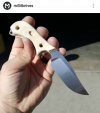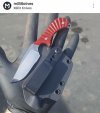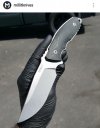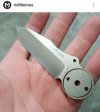Some of it definitely comes down to personal preference. And personal preference comes down to the criteria that are important to you, e.g. looks/craftsmanship or intended use. I think, for example, that a well-executed hollow grind is beautiful to behold. Much more so than, say, a FFG, which one could argue is the most "boring" grind from a purely aesthetic position. Chiral is probably absolutely right when he argues that differences in performance might be minimal. But that doesn't mean that there aren't objectively quantifiable advantages to each grind depending on intended use and that, given the choice, it would be wrong to opt for the "best" alternative.
Leaving aside axes or hatchets because they are, IMO, a very different animal due to their size, weight, thickness etc etc my thoughts (which are actually not "my own" or very original) on the various grinds:
Hollow: more specialized; generally the "weakest" of the grinds (doesn't mean they can't be built thick and strong to compensate); best for hunting knives (cutting thin and/or soft material that naturally parts when cut); not ideal for vegetables, wood (sure, it can do it, but I doubt it would be anyone's first choice due to strength and/or "binding" issues).
FF: very good all-round; good slicer for deeper cuts; can "drag" in certain materials and depending on how steep the grind is; almost all kitchen knives used for cutting vegetables, fine for wood, general utility etc
Convex: generally also good all-round depending on thickness; great for harder tasks, wood; strong; can be more challenging for some to maintain a proper edge
Flat saber: more all-round, though not the "best" slicer; very strong; good for hard-use; not the first choice for kitchen use (whether meat or vegetables where HG and FF are typically better)
Hollow saber: I'm stumped. This is a combination that I admit I don't really understand. But happy to learn.
Scandi: more specialized; wood-working
They all "work", they can all be very pleasing to the eye. I suppose - as stated before - that I was drawn to S!K because of the size/shape of the blades - very strong without being ridiculously "over-built" (relatively "nimble"); very well thought-out. And part of that was the conviction that the flat saber grind was "the best" choice for this type of (strong, stout) knife in all of the size variations.
I'm sure the hollow grind "works" but I do have to question whether the decision was driven more by cost or labor related considerations than performance/function. Are we seeing a departure from Guy's famous "no compromise", "spare no effort" in delivering the absolute best version of this particular type of knife (as opposed to merely delivering "a knife")?
This last point is the one I'm really focused on.
ETA: To
 chiral.grolim
chiral.grolim
's comment above I should add that I took one look at the pic of the new 3.5 and recognized the HG.
I look forward to putting one through its paces (which will likely include batoning dried oak, tin cans, and steel roofing...and throwing)








